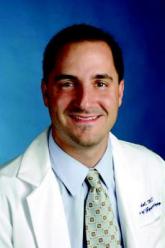News


AT THE ACOG ANNUAL CLINICAL MEETING
SAN FRANCISCO – Occult uterine sarcoma occurred in less than 0.1% of more than 10,000 hysterectomies performed at a large hospital system between 2000 and 2014 for presumed benign gynecologic indications.
Of 10,083 patients who underwent such hysterectomies at University of Texas Southwestern Medical Center hospitals during the study period, 9 were found to have uterine sarcoma (overall rate of 8.9 per 10,000), including 5 with leiomyosarcoma (rate of 4.96 per 10,000) and 2 each with endometrial stromal sarcoma and uterine adenosarcoma (rate of 1.98 per 10,000 for each) Dr. Ken Yu Lin reported at the annual meeting of the American College of Obstetricians and Gynecologists.
The patients’ median age at diagnosis was 39 years, and their median body mass index was 27 kg/m2. Six had prior hormonal therapy, and three reported responding to leuprolide, including two who experienced decreased bleeding, and one who experienced uterine mass size reduction. None had a history of tamoxifen use or pelvic radiation exposure, and one had rapid uterine enlargement and was found to have leiomyosarcoma.
At a median follow-up of 48 months, one had died, one had a recurrence of endometrial stromal sarcoma, and seven were alive with no evidence of disease, Dr. Lin said.
Leiomyomas were associated with significantly larger uterine size (mean weight of 3,500 g), compared with endometrial stromal sarcoma and adenosarcoma, he noted.
Four of five patients with leiomyoma underwent a biopsy prior to surgery, and the results were normal. One underwent manual morcellation during abdominal hysterectomy because of large mass size, but power morcellation was not used in any patient.
The 0.1% frequency of uterine sarcoma in patients undergoing hysterectomy for a benign condition was lower than the frequency in previously reported studies and pooled analyses, Dr. Lin said.
The patients were women who underwent hysterectomy for benign conditions – abnormal bleeding in 78% of cases and leiomyoma in 56% of cases. Five underwent total abdominal hysterectomy, three had a total vaginal hysterectomy, and one had a supracervical hysterectomy.
Occult uterine sarcoma was defined as uterine sarcoma on pathology postoperatively in those with no preoperative suspicion of malignancy, Dr. Lin said.
Hysterectomy is one of the most common surgical procedures in the United States, and outcomes have improved thanks to minimally invasive procedures that require only small incisions.
However, small incisions lead to challenges with respect to the removal of large specimens, Dr. Lin said, adding that morcellation, which has been used to facilitate the removal of tissue in cases involving minimally invasive surgery, has come under scrutiny because of concerns about its role in the dissemination of occult gynecologic malignancies, and particularly uterine sarcoma.
Central to this discussion is the question of the prevalence of occult sarcoma in the setting of hysterectomy for benign indications, he said, noting that the prevalence of occult sarcoma in women undergoing surgery for presumed uterine fibroids has been reported to be as high as 1 in 350 by some authors.
The findings suggest that “clinical practices and regional referral patterns may impact local rates of occult uterine sarcoma and should be considered during patient counseling and when developing clinical recommendations,” Dr Lin concluded.
Dr. Lin reported having no relevant disclosures.


Key clinical point: Among women who underwent myomectomy, the prevalence of cancers was low but increased with age. Major finding: Rates of...
